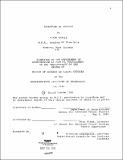| dc.contributor.advisor | Otto Piene. | en_US |
| dc.contributor.author | Kracke, Bernd | en_US |
| dc.contributor.other | Massachusetts Institute of Technology. Dept. of Architecture. | en_US |
| dc.date.accessioned | 2012-12-13T18:36:46Z | |
| dc.date.available | 2012-12-13T18:36:46Z | |
| dc.date.copyright | 1981 | en_US |
| dc.date.issued | 1981 | en_US |
| dc.identifier.uri | http://hdl.handle.net/1721.1/75490 | |
| dc.description | Thesis (M.S.V.S.)--Massachusetts Institute of Technology, Dept. of Architecture, 1981. | en_US |
| dc.description | MICROFICHE COPY AVAILABLE IN ARCHIVES AND ROTCH. | en_US |
| dc.description | Includes bibliographies. | en_US |
| dc.description.abstract | Sculpture as process is rooted in the historical development of movement as a theme of art in general and of sculpture in particular since 1900. The impact of the industrial revolution and the subsequent scientific/technological boom moved sculpture increasingly from static to dynamic models of reality. Scientific research pushed beyond the natural limitations of the senses, expanding man's perception of reality and demanding an ever more encompassing world view. That which was previously unseen, unheard and unknown became tangible in the micro and macro perspectives of the "New Landscape" (Kepes). Change arrived with challenge - to integrate the "New Landscape" with the familiar - and accompanied by turbulent social transformation. Whether rejected or embraced, the machine became an obsessive metaphor for both human progress and destruction. As a synthesis of object and process, it catalyzed the transition from static to dynamic models of reality. The initially rough 'machine aesthetic' led to the development of kinetic sculpture and towards the integration of art, audience and environment. With the introduction of electronics and the computer, movement became less fascinating as an isolated phenomenon by gaining meaning as an integral part of a whole system. Cybernetic mechanisms - regulatory functions controlling input and output of organic and inorganic systems - became important aspects of new perception and models. Processes of communication within systems and between systems came to define a dynamic scale, inversely related, of parts to the whole. Sculpture as process, the term my thesis seeks to define and my installation to embody, generates these communication processes in the environment, materializes and records them as temporary dynamic patterns, and stores them as information in a randomly accessible memory. | en_US |
| dc.description.statementofresponsibility | by Bernd Kracke. | en_US |
| dc.format.extent | iv, 83 leaves | en_US |
| dc.language.iso | eng | en_US |
| dc.publisher | Massachusetts Institute of Technology | en_US |
| dc.rights | M.I.T. theses are protected by
copyright. They may be viewed from this source for any purpose, but
reproduction or distribution in any format is prohibited without written
permission. See provided URL for inquiries about permission. | en_US |
| dc.rights.uri | http://dspace.mit.edu/handle/1721.1/7582 | en_US |
| dc.subject | Architecture. | en_US |
| dc.subject.lcsh | Information storage and retrieval systems Sculpture | en_US |
| dc.subject.lcsh | Telecommunication systems | en_US |
| dc.subject.lcsh | Sculpture Communication systems | en_US |
| dc.title | Sculpture as process | en_US |
| dc.type | Thesis | en_US |
| dc.description.degree | M.S.V.S. | en_US |
| dc.contributor.department | Massachusetts Institute of Technology. Department of Architecture | |
| dc.identifier.oclc | 08176104 | en_US |
